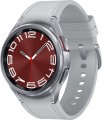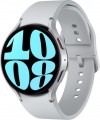Size
The size of the display installed in the gadget; for round screens, respectively, the diameter is indicated.
A larger screen, on the one hand, is more convenient to use, on the other hand, it significantly affects the dimensions of the entire device, which is especially critical for wearable gadgets. Therefore, manufacturers choose the display size in accordance with the purpose and functionality of each specific model — so that there is enough space on the screen and the device itself is not too bulky.
It is also worth mentioning that screens with a similar size may have different aspect ratios. For example, traditional smartwatches are usually equipped with square or round panels, while in fitness trackers, screens are often made elongated in height.
Screen resolution
Screen size in dots (pixels) horizontally and vertically. In general, this is one of the indicators that determine the image quality: the higher the resolution, the clearer and smoother the picture on the screen (with the same size), the less noticeable are the individual dots. On the other hand, an increase in the number of pixels affects the cost of displays, their power consumption and requirements for a hardware platform (more powerful hardware is required, which itself will cost more). In addition, the specifics of using smartwatches is such that there is simply no need to install high-resolution screens in them. Therefore, modern wrist accessories use displays with a relatively low resolution: for example, 320x320 with a size of about 1.6" is considered quite sufficient even for premium watches.
PPI
The density of dots on the screen of the gadget, namely, the number of pixels that are on each inch of the panel vertically or horizontally.
The higher the PPI, the higher the detail of the screen, the clearer and smoother the image is. On the other hand, this indicator affects the price accordingly. Therefore, the higher the density of points, the more advanced, usually, this gadget is in terms of general capabilities. However, when choosing a screen, manufacturers take into account the general purpose and functionality of the device; so that even a small number of PPIs usually does not interfere with comfortable use.
Bezel-less
Bezel-less are displays in which the case or bezel does not occupy the usable area of the front panel, or it is minimized. In terms of design, bezels have both pros and cons. One of the most important reasons for adding substantial bezels to your screen is physical protection.
The bezel-less display is very easy to scratch or damage when dropped. On the other hand, the frame takes up space on the screen, and this is one of the reasons why the frames in modern smartwatches are minimized, making the gadget more compact and stylish.
Battery capacity
The capacity of the battery that is installed in the gadget.
Theoretically, the higher the capacity, the longer the battery can work on a single charge. However, in fact, the battery life of the gadget also depends on its power consumption, and it is determined by the specs of the display and the hardware. Therefore, only models of the same type with very similar specs can be compared in terms of battery capacity; and for an accurate assessment of battery life, it is better to focus on the directly claimed operating time in one mode or another (see below).
It is also worth mentioning that high-capacity batteries inevitably turn out to be quite heavy and bulky. So the capacity of batteries installed in wearable gadgets is also greatly limited by size and weight.
Material
The material from which the body of the gadget is made. Some models are available in several versions, made of different materials — for example, aluminium or steel; for such cases, all available options are indicated in the specs at once.
—
Plastic. Plastic is often considered a low-cost option, but this is not true in the case of wearable gadgets: such devices can use different types of plastic, including very advanced, durable and reliable ones. So the overall quality of such a case, usually, directly depends on the price category of the device. The common advantages of all types of plastic are relatively low weight, resistance to moisture, the ability to give the body any colour and shape, as well as low thermal conductivity.
—
Metal. Cases made of metal, for which the manufacturer, for some reason, did not specify the specific composition. However, most often in such cases we are talking about
aluminium or
steel, see below for more details on both. But high-end materials such as
gold or
titanium are rarely hidden under the modest term "metal" — they are usually indicated directly in the specifications. Anyway, in general, metal cases are somewhat stronger and more reliable than plastic ones, they also look more solid, but they are also more expens
...ive.
— Steel. Usually, stainless steel is used for wearable gadgets. It is highly durable and reliable, does not corrode, looks stylish and neat, and is relatively inexpensive — cheaper than many aluminium alloys, not to mention titanium. One of the peculiarities of steel cases is rather heavy weight, but it can be both a disadvantage and an advantage: a massive case creates an additional feeling of reliability and solidity. It should be noted that most gadgets with steel cases have round dials and a traditional design, which is well suited even to a business style, but occasionally there are exceptions.
— Aluminium. Aluminium alloys combine high strength and low weight — much less than steel. But this material is somewhat more expensive. It is also considered well suited for bright youth gadgets, although it is occasionally used in more traditional devices.
— Rubber. A material found in some models of children's beacons and fitness trackers (see "Type"), but almost never used in other types of wearable gadgets. One of the key advantages of rubber is softness, which gives a certain degree of impact protection and makes the case as safe as possible; both are especially important for children's devices. In addition, such a case can be easily made waterproof and even completely sealed, as well as made in any colour. On the other hand, plastic has practically the same advantages (except for softness), and rubber costs a little more (although it is noticeably cheaper than metals).
— Titanium. Titanium alloys are premium materials and are rarely used, mainly in top-tier models of “extreme” gadgets. This material is light and at the same time extremely durable, besides it perfectly holds its shape when struck; however, titanium costs much more than the same aluminium, despite the fact that high reliability is not so often decisive.
— Gold. Gold or gold-plated case turns the gadget into a stylish fashion accessory. Such a case is very expensive, but this cannot be called a disadvantage: the price of the device emphasizes the status of the owner.
— Ceramics. Special high-strength ceramics is another premium material that not only performs a practical function, but also demonstrates the high level of the gadget and the solidity of its owner. On the practical side, in addition to strength and reliability, this material has extremely high scratch resistance, which allows it to retain its looks for a very long time even in not very favorable conditions. At the same time, ceramics do not tolerate strong point impacts.Bezel
Swivel ring around the round dial of the smartwatch.
Bezel exists for a decorative and protective purpose, and in many models it has additional markings and provides a number of special control options. By rotating it, you can navigate through the menu of the smartwatch, and it also simplifies interaction with the touch screen of the wearable device. On the bezel, special marks are often applied for the operation of the watch dial in the timer or stopwatch mode. The specific implementation of the features assigned to the ring depends on the specific model of smartwatch.
— Metallic. The metal bezel has high mechanical strength. Usually it is made of stainless steel.
— Plastic. A low cost version of the bezel, which is found in smartwatch models with plastic cases.
Strap Options
—
Skin. Leather straps are typical for a business style, they look rich and respectable, however, they are quite expensive. On the practical side, this material is strong, reliable and resistant to moisture; at the same time, it is quite demanding to care for, and if the appropriate rules are not followed, cracks may appear on the strap.
—
Rubber/silicone. Quite a popular material used not only for fitness trackers, but also for traditional watches. Rubber straps do not look as rich as leather ones, but they are also quite decent, while they are strong enough, durable, resistant to moisture and pleasantly felt on the hand. Silicone is similar in properties, which in appearance is practically indistinguishable from rubber. But the silicone is softer, does not pinch the hand and is more pleasant to the touch.
—
Metal. Metal straps (bracelets) are mainly made of stainless steel, but there are other options. Anyway, bracelets are highly durable and can be both light and massive, depending on the composition of the metal. It is also worth mentioning the high thermal conductivity of this material. Such a bracelet pleasantly cools the hand in the warm season, but causes the opposite effect in the cold.
—
Milanese bracelet. Metal bracelets made of links of very fine weaving (about 1 mm in size, or even less). The m
...aterial of such a bracelet may be different; most often it is steel, but more expensive metals are also found. Anyway, such a bracelet has an original appearance, and also provides good air access, allowing the skin to breathe. Among the shortcomings of Milanese bracelet, it can be noted that the links can “bite” the hair on the arm, creating discomfort.
— Textile. Usually, strong dense fabric (like nylon-based CORDURA) is used for straps, resistant to moisture, ultraviolet and other adverse factors. For some users, this material is more pleasant than other options; however, for a number of technical reasons, fabric straps were not widely used.
Many models of wearable gadgets are available with several strap options to choose from.Weight
In most cases, the weight of the watch body itself is indicated as the weight of the model, since the strap is removable and can be replaced with another one. However, there are also models when the weight is presented with an included strap. Anyway, if the manufacturer indicates a specific method of measuring weight (with or without a strap), we add this information.

